Trust Stock List
Motive Power
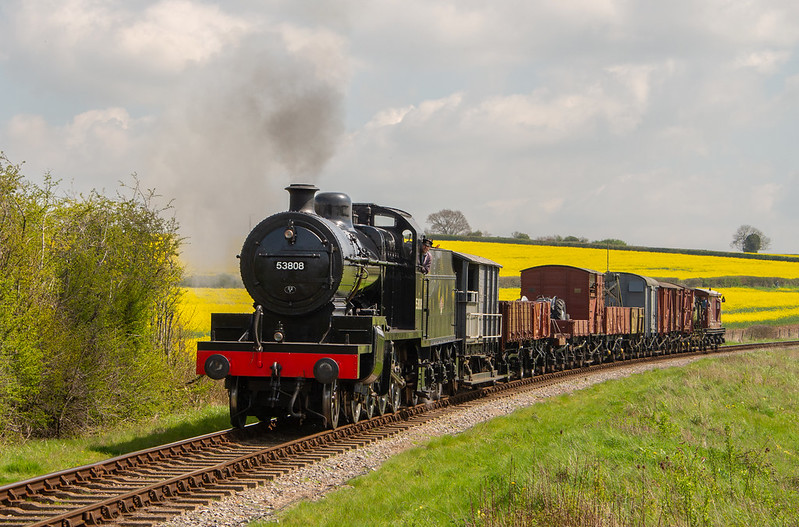
SDJR 7F 2-8-0 No. 88
The Trust’s largest and heaviest museum exhibit is former SDJR 7F 2-8-0, No. 88, built in 1925. It now carries its BR number, 53808. Restored from scrapyard condition between 1969 and 1987, the locomotive was in regular service with the West Somerset Railway until 2019. The locomotive moved to the Watercress Line (Mid-Hants Railway) on long-term hire in August 2020.
53808 first appeared in service on the Watercress Line for the 2020 Autumn Steam Gala, as can be seen in this video. With the releasing of Covid restrictions and the completion of work on the cylinder steam pipe, 53808 re-entered service on 12 June 2021 as seen in this video. See our YouTube channel for further videos of 53808.
The boiler certificate ran out at the end of 2023 so the locomotive is currently out of service. Negotiations are currently taking place regarding the overhaul which we hope to be able to announce soon.
[Photo by Tony Storey during the Spring Steam Gala in 2023.]
See these pages dedicated to 53808 for more information:
Latest photos. 53808’s history. How the S&D 7Fs came into being. 53808’s Restoration. The Return to Steam in 1987.

Peckett 0-4-0ST Kilmersdon
Built in 1929 with works number 1788, Kilmersdon was the last steam locomotive to work the Somerset Coalfield. The locomotive was on a long hire to the Helston Railway in Cornwall from May 2018 to January 2020 and then moved to the Watercress Line in Hampshire in March 2021. The loco finished overhaul and returned to service in August 2022. [Photo by Andrew Woodroffe.]
Before going to Helston, Kilmersdon regularly appeared along with our fully-restored 1886 S&D carriage, Coach 4, during West Somerset Railway galas at Minehead where for a small fee, visitors could experience first class travel from times long past.
Videos of Kilmersdon: At Minehead, hauling S&DJR Coach 4 in 2016. At the Helston Railway in 2018. The last day of steaming at Helston, January 2020. At Midsomer Norton, just a few miles from Kilmersdon village, in November 2023.
Here is archive colour film footage of Kilmersdon (then just known as No. 1788) at work in Somerset. Kilmersdon Colliery closed in 1973.
Carriages

S&D First class 4-compartment 6-wheel carriage No. 4
Coach 4 was built in the S&D’s own works at Highbridge, Somerset, in 1886.
After withdrawal in around 1930, the carriage body was converted for use as a cricket pavilion at Templecombe and there it remained for the next half century (in terms of time rather than cricket!). The vehicle was rescued by the Trust in 1986 and is now fully restored.
While based at Washford, the coach was often been seen at the ends of the West Somerset Railway with short runs out of Minehead station during galas and, as pictured here, on the platform at the Norton Fitzwarren steam rally.
The carriage has now moved on loan to the new Hornby One:One collection at Margate, Kent. In time, it is envisaged that this carriage could join the two Third Class carriages (below) to form a vintage S&D train.
[Photo by Rod Ormston.]

S&D Third class 5-compartment 6-wheel carriage No. 114
Built in the S&D’s own works at Highbridge, Somerset, in 1890, retired by the SR (as 1423) in 1930 and converted to form a bungalow in Sussex (with No. 98). Recovered by the Trust in 1996 and awaiting restoration.
This carriage moved to the North Dorset Railway at Shillingstone in May 2023. It is hoped that restoration can be considered.
[Photo by Rod Ormston.]
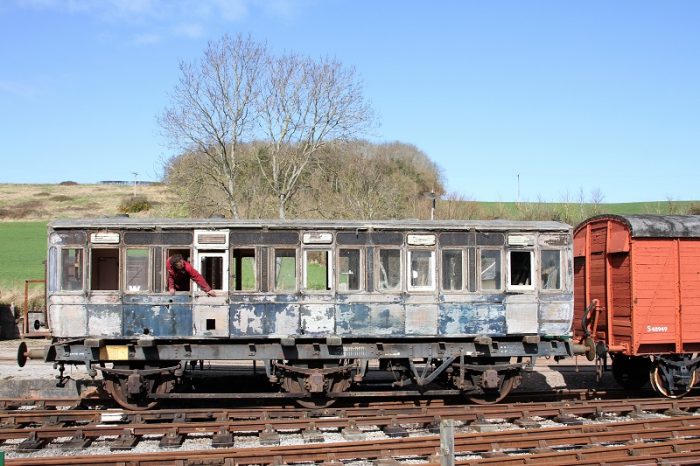
S&D Third class 6-wheel carriage No. 98
Built by Cravens in 1894, No. 98 is virtually identical to coaches built at Highbridge and very similar to many built for the Midland Railway around that time. Awaiting restoration.
This carriage moved to the North Dorset Railway at Shillingstone in May 2023. It is hoped that restoration can be considered.
[Photo by Beverley Zehetmeier.]

MkI Brake Gangwayed (BG) carriage No. 80972
This was built for BR in 1956 and was acquired by the Trust in 2018. It has now been refurbished to provide extra museum space.
The carriage moved to the Watercress Line in November 2021.
[Photo by David Temple.]
Brakevan

London & South-Western Brakevan (Road Van) (12424)
The L&SWR brake van No. 54885 was built around 1900/1902; its first number was 12424. It moved from the Longmoor Military Railway to the East Somerset Railway in 1973, moving on to Washford in 1988. It was rebuilt by Trust volunteers in the late 1990s. The van moved to the Watercress Line in May 2021.
‘Road vans’ were a type of brake van that was also able to carry light goods (‘smalls’) – note the double doors. The L&SWR had almost 500 built between 1884 and 1905 and 444 of them passed into the ownership of the Southern Railway in 1923 with several passing to British Railways upon nationalisation in 1948. The last example on the national network was withdrawn in 1967.
The van was pictured in June 2023 having benefited from an excellent paint job by the volunteers at Medstead.
[Photo by Chris Le Corney.]
Vans

London & South-Western Ventilated Van
The brown van (42106) with the sliding doors intact is from 1901. Mansell wheels (steel & wood construction). [Photo by John Cannon.]
![Van 42xxx at Washford. [Photo by David Temple.]](http://www.sdrt.org/wp-content/uploads/2021/08/van_42xxx_washford-david_temple.jpg)
London & South-Western Fruit Van (RNAD 7401)
This ventilated van was built in around 1909 for the carriage of fruit and arrived with the Trust in 1984.
Its original L&SWR number is unknown, as is the SR number, though the latter would have been in the form of 42XXX. The van carries the number 42085 even though the exact number is unknown.
The van was acquired by us from RNAD Bedenham and while there, it carried the number 7401.
This vehicle moved to the Watercress Line in August 2021.
[Photo by David Temple.]

London & South-Western Ventilated Van RNAD 304, given number 51171
This van was built in 1909 and although its original number is unknown, it was later numbered RNAD 304, and 51171 was used by the Southern Railway. The van had arrived at Washford in 1984 having previously been located at RNAD Bedenham.
LOH 18ft WB 11ft LSWR mixed Panter and Shepherd axleboxes, Mansell wheels, long springs, LSWR plain buffer casings. 1898 wheelsets. Doors changed to SDJR design, and van currently numbered 747 – though this is not one of its official numbers.
The van moved to the Watercress Line in May 2021.
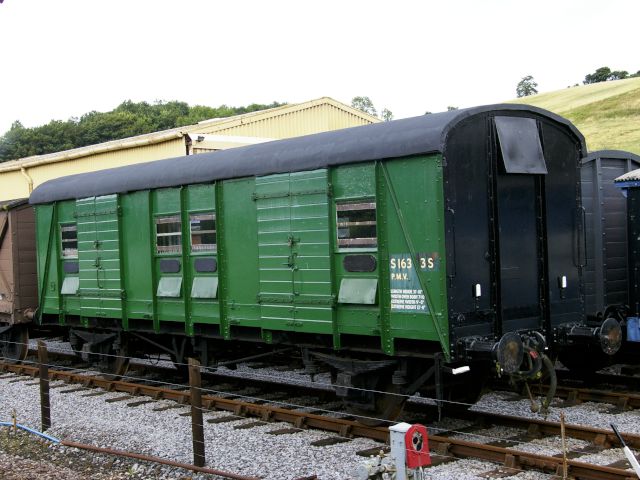
Southern Railway – style Parcels & Miscellaneous Van S1633S
Built by BR to a Southern Railway design, the PMV has been restored to original condition. Internal length 31′ 10″.
On 9 November 2020, the PMV moved to the Watercress Line.

London Midland & Scottish Van 37103 CCT
This Covered Carriage Truck was built by Metro-Cammell in 1938 under Lot No. 1154 and to diagram 2026, and known by the LMS as a Covered Motor Car Van.
At some point, this vehicle has also carried the number DM396003.
This vehicle moved to the North Dorset Railway at Shillingstone in June 2023.

British Railways Fruit D (W3450W)
Built by BR at Swindon to a GWR design (Y14 diagram, lot no. 1771) in 1955. Condemned in 1976 at Reading, purchased privately, then transferred to the S&DRT. [Photo by John Cannon.]
The van is now fitted out with seating and a video screen for cinema purposes and has previously travelled to the Norton Fitzwarren steam fayre where it has been used for the serving of refreshments.
This vehicle moved to the North Dorset Railway at Shillingstone in June 2023.
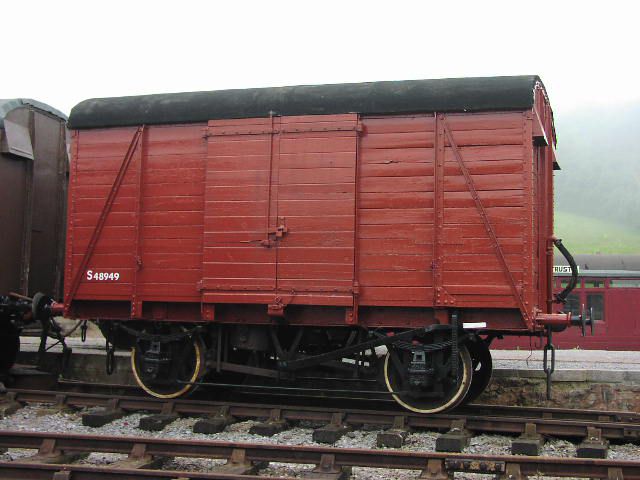
Southern Railway Box Van S48949
Built to a standard pattern between 1935 and 1949.
This vehicle was moved to the Watercress Line in June 2021.
[Photo by John Cannon.]

London Midland & Scottish 12 ton Steel Van (LMS 179162).
ca. 1930. [Photo by John Cannon.]
This van moved on loan to the North Dorset Railway on 10 March 2023.
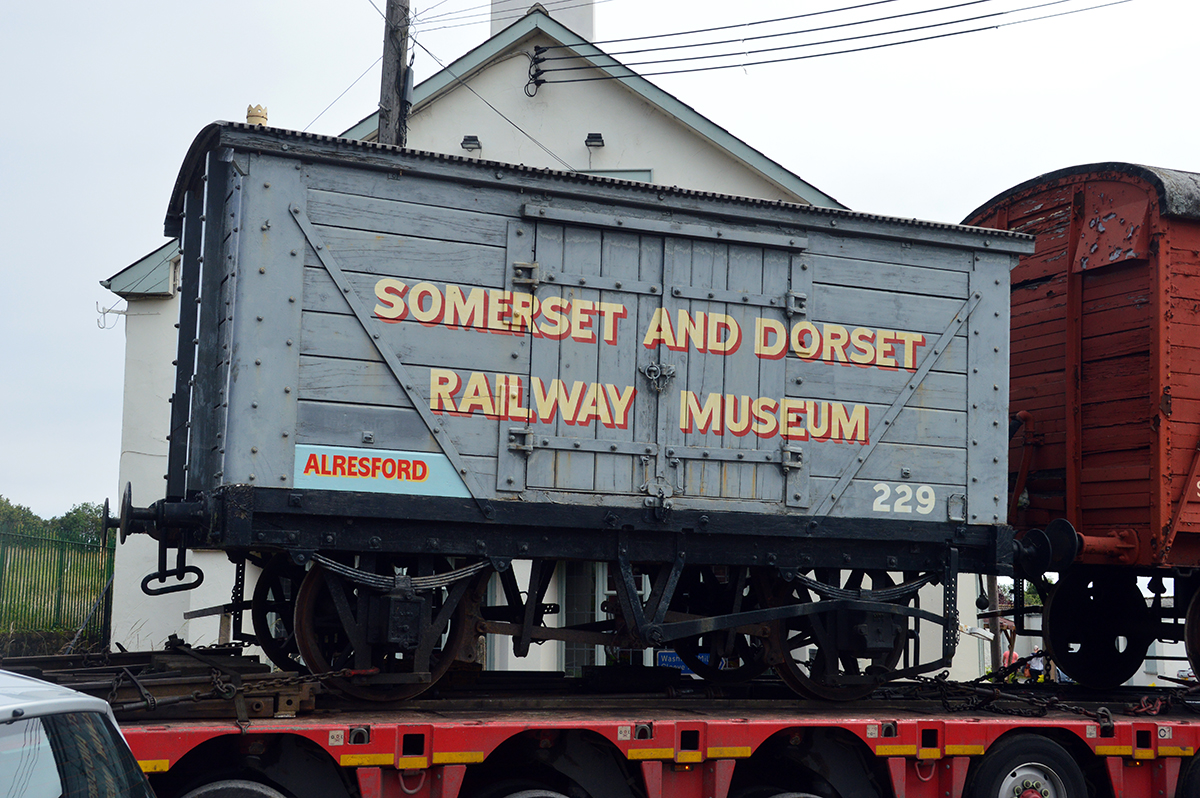
Military Van RNAD 229
This non-ventilated van with 10 tons load capacity was designed specifically for the Royal Naval Armament Depot and was received by the Trust from RNAD Bedenham.
LSWR affiliations are visible; wheelset marked “LSWR Co 1886”. LOH 15ft 4in, wheelbase 9ft 2in. Mixed axleboxes, all LSWR: one Shepherd’s dated 1927, another Warner’s Box B 9in x 4in.
This vehicle moved to the Watercress Line in June 2021 and is seen here on the transport leaving Washford. The van advertised the museum to passing train passengers and before departure, the marking of ‘Washford’ was changed to ‘Alresford’ as can be seen in the photo.
[Photo by David Temple.]
Open & Flat Wagons

LMS D1671
Some 31,000 of these wagons were built by the LMS at Earlestown and Derby, and for the LMS by private builders, between 1924 and 1940. They were very similar to the RCH 1923 Standard 12 ton mineral wagon design. As well as the LMS, the LNER also adopted the design as the standard mineral wagon – number built unknown, but at least 6,000. In addition, an estimated 234,000 of the RCH 1923 Standard design were built by the trade for private owners between 1923 and 1940. [Photo by Chris Nevard.]
This wagon moved on loan to the North Dorset Railway on 10 March 2023.

NE 10 ton 424023 (RNAD 194)
Originally designed for the Great Northen Railway, the original number of this 10-ton capacity wagon is unknown, though it carries the number 424023.
It was acquired by the Trust from RNAD Bedenham where it carried the number 194.
LOH 15ft 10in WB 9ft 4in. LMS and LNEC 8×4 axleboxes. Self contained buffers. [Photo by John Cannon.]
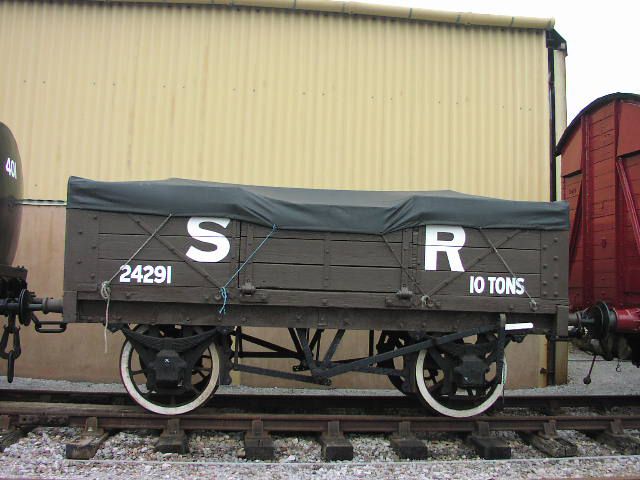
LB&SCR open 4-plank no. 24291 (RNAD 119)
This wagon of 10 tons capacity was built for the London, Brighton & South Coast Railway.
Its first number – 24291 – is that which it carries today. The wagon was acquired by the Trust in 1993 from RNAD Bedenham where it carried the number 119.
LOH 15ft 5in, WB 9ft 2in. Three SR(E) and one SR(B) No 7 axleboxes.
This vehicle moved to the Watercress Line in August 2021.
[Photo by John Cannon.]
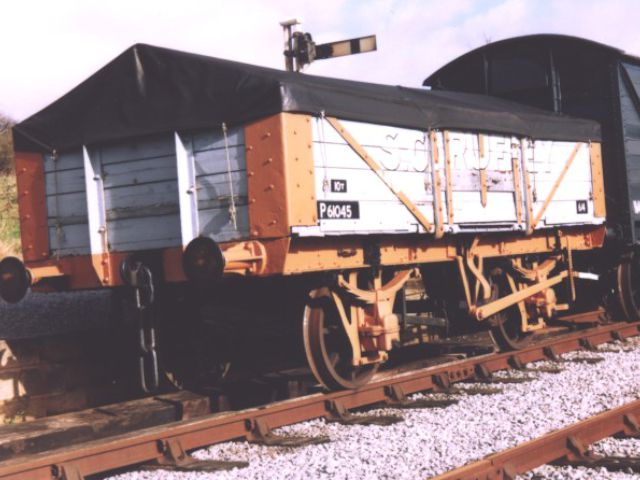
LMS Open 4 Plank P61045
Ex-Port of Bristol Authority wagon built by the LMS in 1932. 5-planks; steel frame; full height door. Currently masquerades as S C Ruffey’s wagon based at Sodor. [Photo by George Moon.]
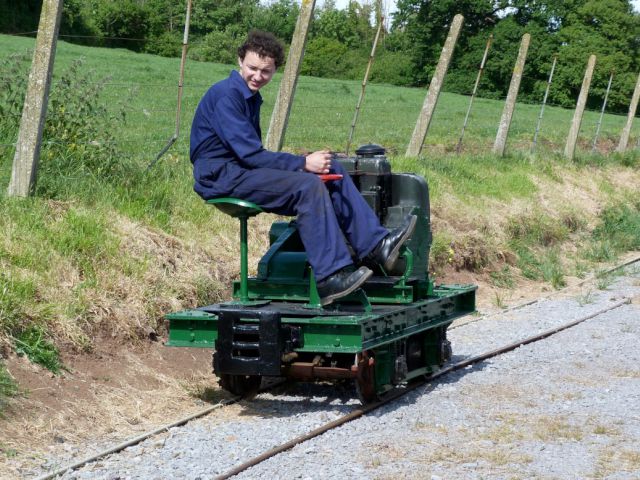
Narrow gauge track, locomotive & stock
From the Ashcott Peat Works Railway, which crossed the S & D on the level. [Photo by Gerry Leyman.]
This has moved to the Westonzoyland Pumping Station on the Somerset levels.
At Washford, an information panel provided visitors with the background to the railway.
